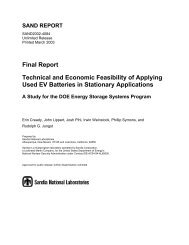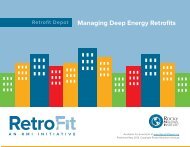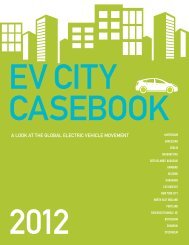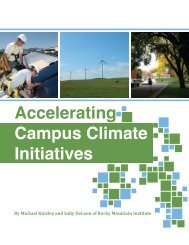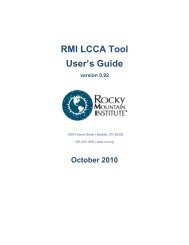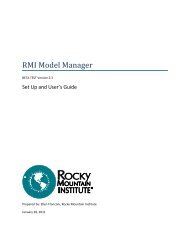Fleet Electrification Roadmap
Fleet Electrification Roadmap
Fleet Electrification Roadmap
- No tags were found...
You also want an ePaper? Increase the reach of your titles
YUMPU automatically turns print PDFs into web optimized ePapers that Google loves.
148 key to termsfleet electrification roadmap149Key to TermsACES 2009 American Clean Energy and Security Act of 2009.Advanced MeteringAdvanced TransmissionAmpereAdvanced electrical metering enables measuring and recording of usage data at regular short intervals andprovides this data to both consumers and energy companies.Electricity distribution that employs digital metering to improve provider communication and monitoringcapability as well as permit the efficient management of power flows, especially from variable renewable sources.A measure of electrical current which represents a flow of one coulomb of electricity per second.ARRA 2009 American Recovery and Reinvestment Act of 2009.Battery-Electric Vehicle (BEV)Blended ModeCarbon Dioxide EquivalentsCharge-Depleting (CD) ModeCharge-Sustaining ModeDirect-Injection TransmissionDrivetrainA type of electric vehicle (see below) that is propelled by an electric motor and uses the chemical energy storedin on-board batteries to power the motor.In a hybrid-electric vehicle, operating in blended mode uses both an electric motor and a gasoline engine operatingsimultaneously and in conjunction to power the vehicle’s drivetrain.The amount of carbon dioxide by weight emitted into the atmosphere that would produce the same estimatedradiative forcing as a given weight of another radiatively active gas.EVs and PHEVs operating in charge-depleting mode are drawing motive power and energy from the battery andreducing its state of charge. EVs always operate in charge-depleting mode.PHEVs in charge-sustaining mode are supplementing battery power with another source of energy, most commonlyfrom a gasoline-powered onboard generator. The battery's state of charge is not being reduced. HEVs essentiallyalways operate in charge-sustaining mode.A means of increasing power output and fuel efficiency in internal combustion engines. Gasoline is directlyinjected into the combustion cylinder, as opposed to fuel injection, when it is injected into the air intake.Also called the powertrain, the set of components for transmitting power to a vehicle’s wheels, including theengine, clutch, torque converter, transmission, driveshafts or axle shafts, U-joints, CV-joints, differential and axles.EISA 2007 Energy Independence and Security Act of 2007.Electric Drive Vehicle (xEV)Electric MotorElectric Vehicle (EV)Electric Vehicle Miles Traveled (EVMT)Electric MileElectric Vehicle Supply Equipment(EVSE)Extended-Range Electric Vehicle(E-REV)An inclusive term that refers to vehicles that incorporate some form of battery electric power in the drivetrain.Includes hybrid electric vehicles (HEVs); plug-in hybrid electric vehicles (PHEVs); Extended-range Electric Vehicles(EREVs); and electric vehicles (EVs).Transforms electrical energy into mechanical energy. In a grid-enabled vehicle, the electricity is supplied by the battery.A vehicle propelled 100 percent by an electric motor, which forms part of an electric drivetrain. The power comesin the form of current from an on-board storage battery, fuel cell, capacitor, photovoltaic array, or generator.The number of electric miles traveled nationally for a period of 1 year.For an electric vehicle, an electric mile is any mile in which the vehicle is propelled by an electric motor. ForPHEVs or E-REVs, an electric mile is the total miles traveled multiplied by the percent of total power provided byelectricity from the grid.The hardware of electric vehicle charging infrastructure, including public charging stations and wall- or polemountedhome vehicle chargers.Sometimes called series or serial plug-in hybrids. E-REVs are electric drivetrain vehicles that rely on an electricmotor to provide power to the drivetrain but which also include a gasoline internal combustion engine serving asan electrical generator to either provide electricity to the vehicle’s electric motor (supplementing the battery’sstored power) or to maintain the battery’s state of charge as it nears depletion. The gasoline engine is not usedto directly provide mechanical energy to the drivetrain.Internal Combustion Engine (ICE)IOCKilowatt (kW)Kilowatt-hour (kWh)LoadMild HybridNOCOriginal equipment manufacturer(OEM)Parallel HybridPeak Demand (or Load)Plug-In Hybrid Vehicle (PHEV)Power InverterPowertrainResidual Battery ValueSeries HybridSpare Oil Production CapacityTotal Cost of Ownership (TCO)TransformerTransmissionVehicle Miles Traveled (VMT)An engine that produces power by combining liquid fuel and air at high temperature and pressure in a combustionchamber, using the resulting gas expansion for mechanical energy. Conventional vehicle IC engines use twostrokeor four-stroke combustion cycles, which combust intermittently.An oil company that is fully or majority owned by private investors.A unit of power equivalent to 1,000 watts, 1,000 joules per second or about 1.34 horsepower.A unit of energy or work defined as the amount of energy released if work is done at a constant rate of 1 kW for 1 hour,equivalent to 3.6 megajoules. Commonly used to bill for the delivery of electricity.The amount of power (sometimes called demand) consumed by a utility system, individual customer, orelectric device.Hybrid systems that only stop the engine during idle (while still running heat, A/C etc.), and instantly start it whenthe vehicle is required to move, providing efficiency gains in the 5 to 10 percent range.An oil company that is fully or majority owned by a national government.A company that produces a product designed for the end user, whether a consumer or another manufacturingfirm. For example, an automotive OEM sells vehicles to consumers, typically through a dealer network; however abattery OEM may sell batteries only directly to automotive manufacturers.Hybrids that have an IC engine and electric motor that both provide torque to the wheels. In some cases, the ICengine is the predominant drive system with the electric motor operating to add extra power as required. Otherscan run with just the electric motor driving.The greatest electricity demand that occurs during a specified period of time.A form of HEV that generally has larger batteries, allowing it to derive more of its propulsion from electrical powerthan from the IC engine. PHEVs are, as a result, far more efficient in their use of energy than typical HEVs. Thesebatteries can be recharged by connecting a plug to an external electric power source.An electronic device that converts direct current (DC) into alternating current (AC) or AC into DC.See Drivetrain.The value of a battery established by the market after it has completed its primary purpose service life.A vehicle which has an IC engine and electric motor, but only the electric motor provides torque to the wheels.A series hybrid is therefore essentially an electric vehicle with a fossil fuel recharging system on board. Bothsources of power can be used if necessary.The amount of dormant oil production capacity which could theoretically be brought online within 30 days andwhich can be sustained for 90 days. Generally, only OPEC members maintain spare production capacity.A measure of the entire undiscounted cost associated with the purchase, maintenance, usage, and disposal of aproduct spread evenly over the expected service life.A device that transfers electrical energy from one circuit to another, converting electricity from one voltageto another, performing the step-down or step-up necessary to enable high voltage, low current transmission,minimizing losses over long distances.Interconnected group of lines and associated equipment for the movement or transfer of electric energy betweenpoints of supply and points at which it is transformed for delivery to customers or is delivered to other electric systems.The number of miles traveled nationally by vehicles for a period of one year.Full HybridGeneratorGrid-enabled Vehicle (GEV)Hybrids that provide enough power for limited levels of autonomous, battery-powered driving at slow speeds.Efficiency gains ranging from 25 to 40 percent.Converts mechanical energy from an engine into electrical energy.Electric or hybrid-electric vehicles that can be plugged directly into the electric grid to recharge onboard batteries.



